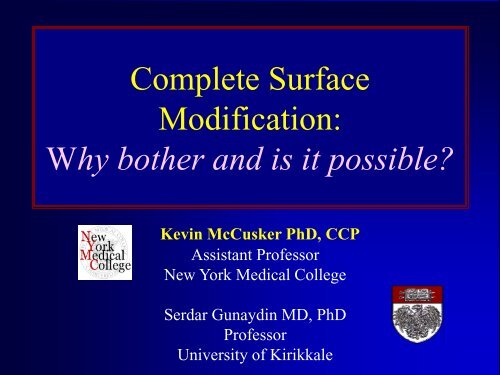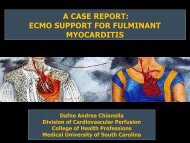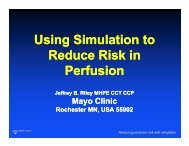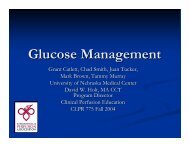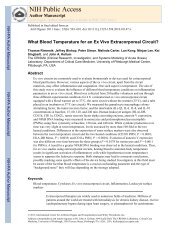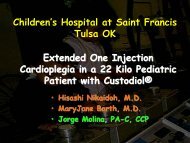PowerPoint Presentation (PDF) - Perfusion.com
PowerPoint Presentation (PDF) - Perfusion.com
PowerPoint Presentation (PDF) - Perfusion.com
You also want an ePaper? Increase the reach of your titles
YUMPU automatically turns print PDFs into web optimized ePapers that Google loves.
Complete Surface<br />
Modification:<br />
Why bother and is it possible?<br />
Kevin McCusker PhD, CCP<br />
Assistant Professor<br />
New York Medical College<br />
Serdar Gunaydin MD, PhD<br />
Professor<br />
University of Kirikkale
Modified Extracorporeal<br />
Circuits to Attenuate SIRS:<br />
Everything is possible?<br />
Kevin McCusker PhD, CCP<br />
Assistant Professor<br />
New York Medical College<br />
Serdar Gunaydin MD, PhD<br />
Professor<br />
University of Kirikkale
NO Sour Faces!
177 cm, 60 Kg<br />
Marathon Runner<br />
Healthy lifestyle promoter<br />
Died MI, age 52 (while running)<br />
Father died MI age 43<br />
172 cm, 122 Kg<br />
Slothful<br />
Legendary gluttony<br />
Smoker<br />
Died age 90
Are We Evolving ?
Factor XII<br />
Kinin<br />
Generation<br />
Angiotensin<br />
System<br />
Complement<br />
System<br />
Inflammatory Response<br />
Factor XIIa<br />
HMW-Kininogen<br />
Bradykinin<br />
Prorenin<br />
Renin<br />
C 1<br />
Prekallikrein<br />
Kallikrein<br />
_<br />
C 1<br />
Plasminogen<br />
Factor XII<br />
Factor XIIa<br />
Factor XI<br />
Factor XIa<br />
Plasmin<br />
Coagulation<br />
System<br />
Fibrinolytic<br />
System
BACKGROUND<br />
• The continuous interaction of blood with artificial contact<br />
surfaces used in CPB leads to substantial damage of cells<br />
and plasma proteins, the release of various inflammatory<br />
cytokines and activation of coagulation and fibrinolytic<br />
systems<br />
• To diminish the negative side-effects of the contact of<br />
blood to foreign surfaces, coating techniques have been<br />
developed<br />
• Hemo-bio<strong>com</strong>patibility, cellular and protein conservation<br />
are among the most important issues in recent research
BACKGROUND-2<br />
• New Advancements: polymer strain<br />
developed for use in CPB by polymerizing<br />
the monomer<br />
• Backbone is hydrophobic and pendant<br />
groups having mild hydrophilicity with no<br />
chemical functioning groups.<br />
• Outer side of the molecule is inactive<br />
chemically, its surface would have little<br />
tendency to react with blood <strong>com</strong>ponents
BACKGROUND-3<br />
• Bio<strong>com</strong>patible and high performance of coated<br />
circuits with clear advantages were demonstrated<br />
by in vitro and ex vivo experiments, applying very<br />
unique technology :<br />
- blocks initiation of platelet adhesion and clot<br />
activating factors<br />
- reduces adsorption and degeneration of proteins<br />
- minimizes attachment of cells in the oxygenator,<br />
tubing and filters<br />
- Low toxicity and leaching
Biological Response to<br />
Implanted Materials in Blood<br />
Red blood<br />
cell<br />
Protein<br />
adsorption<br />
Platelet<br />
adhesion<br />
Fibrin and<br />
thrombus<br />
formation<br />
Material<br />
surface<br />
Platelet<br />
Fibrin
COATING TECHNOLOGY<br />
• 1250 A.D. „De Proprietatibus Rerum‟<br />
(Properties of Things: Surface preparations for metal-metal<br />
bonding)<br />
• 18th Century: Dobereiner, Faraday<br />
(Surface-induced catalysis)<br />
• 1922: J Loeb<br />
(Proteins and Theory of Colloidal Behaviour)<br />
• 1946: Langmuir<br />
(Molecular Films, The Cyclotron & the New Biology)<br />
• 1963: Gott<br />
(Heparin Surface Coating)
Recent advances in<br />
bio<strong>com</strong>patible surface-modifying<br />
additives for cardiopulmonary<br />
bypass<br />
K. McCusker PhD, CCP<br />
V. Vijay M.D<br />
S. Gunaydin MD, PhD<br />
<strong>Perfusion</strong> 2003
How does PMEA<br />
work?<br />
Water in blood<br />
collects at<br />
coating’s<br />
hydrophilic<br />
interface<br />
Blood exposed to<br />
“friendlier” surface,<br />
not the raw plastics<br />
or metals
How does PMEA work?<br />
Proteins are not<br />
denatured<br />
Platelet<br />
adhesion on<br />
surface is<br />
minimized
Heparin-Immobilized<br />
Surfaces<br />
• Bio<strong>com</strong>patible<br />
• Non-leaching<br />
• Bi-polymer Coating with Heparin<br />
• FDA Clearance
CURRENT COATING TECHNOLOGIES<br />
HEPARIN<br />
POLYMER<br />
POLYMER BASED HEPARIN BONDED
Trillium Biopassive Surface
HEPARIN COATING<br />
• Heparin-coated circuits have improved<br />
bio<strong>com</strong>patibility<br />
• Decreased inflammatory response to CPB<br />
BUT…..<br />
• Thrombogenesis is not reduced<br />
• Complete systemic heparinization should be<br />
maintained to avoid <strong>com</strong>plications secondary to the<br />
activation of coagulation<br />
• Cost-effective ?
HYALURONAN<br />
• About 1-10% of the cartilage<br />
glycosaminoglycans is hyaluronan<br />
• It is widely distributed in other<br />
tissues, e.g. skin, eye, and in most, if<br />
not all, body liquids<br />
• The term hyaluronan has lately<br />
substituted the terms hyaluronic<br />
acid and hyaluronate<br />
• Its structure is the simplest of all<br />
glycosaminoglycans<br />
• Hyaluronan is used in medical<br />
applications for its unique<br />
physical/chemical properties. It is<br />
very hydrophilic; its viscous<br />
solutions have most unusual<br />
rheological properties and are<br />
exceedingly lubricious
GBS TM (GISH Bio<strong>com</strong>patibile Surfaces) Coating<br />
• GBS TM coating is<br />
a heparin based,<br />
covalently bond,<br />
bio<strong>com</strong>patibile<br />
coating.<br />
• Hyaluronan<br />
exhibits both<br />
hydrophilic and<br />
hydrophobic<br />
properties<br />
Sorin<br />
Hyaluranon groups<br />
Heparin groups
Rheological Properties<br />
In solution , the very large linear polymer chains takes on the form of<br />
expanded random coils and these chains entangle with each other at very<br />
low concentrations which may contribute to the unusual rheological<br />
properties (pseudoplastic)<br />
Lubricity<br />
There is evidence that hyaluronan separates most tissue surfaces that slide<br />
along each other. Solutions of hyaluronan are extremely lubricious and<br />
have been shown to reduce postoperative adhesion formation following<br />
surgery<br />
Hydrophilicity<br />
HYALURONAN<br />
The polymer takes up a stiffened helical configuration attributed to<br />
hydrogen bonding between the hydroxyl groups along the chain, forming a<br />
coil structure that traps water approximately 1000 times its weight in water
Clinical Performance and<br />
Bio<strong>com</strong>patibility of Novel<br />
Hyaluronan-Based Extracorporeal<br />
Circuits<br />
S Gunaydin MD, PhD<br />
K McCusker PhD, CCP<br />
V.Vijay MD<br />
Journal Extra-Corporeal Technology<br />
2005 Sept.37 (3): 290 – 295.
SOFTLINE<br />
WHERE DID SOFTLINE COME FROM?<br />
– Based on Glycerol-Polyethylenglycol-<br />
Rizinoleat (GPR)<br />
– GPR is used as an excipient in the<br />
pharmaceutical industries for many years<br />
– GPR is pharmacological absolute harmless<br />
(expert testimony from 3rd party)
SOFTLINE<br />
HOW DOES IT WORK?<br />
– Adhesion to surface via intra-molecule interaction of<br />
the lipophilic part (van-der-Waals-Forces)<br />
– Hydrophilic part directed to the blood<br />
– GPR is watersoluble<br />
– No active interaction with physiological processes<br />
(biologically inert)<br />
– Physicochemical modification of surface properties<br />
(improved hydrophilicity)<br />
– Reduced protein adsorption and protein denaturation<br />
– Reduced cell adsorption and cell activation
SOFTLINE<br />
WHAT ARE THE EFFECTS OF COATING?<br />
– Immobilization of water from the contacting aqueous<br />
fluids<br />
– Adsorbed water in addition with the coating substance<br />
acts as a steric hindering*<br />
– Original surface of the device is not reachable for blood<br />
<strong>com</strong>ponents<br />
– The “Soft”, hydrated surface reduces protein<br />
denaturation and cell activation.<br />
(*) A steric hindrance occurs when the sizes of groups<br />
within a molecule prevents chemical reactions observed<br />
in related smaller molecules.
SOFTLINE ATTRIBUTES<br />
– Hydrophilic<br />
– Full synthetic<br />
– Heparin FREE<br />
– No use of human or animal derived substances in the<br />
coating<br />
– Waterbased coating process
METHODS<br />
In a six-month period, 100 patients (EuroScore 6+ ) were prospectively<br />
randomized to one of the two perfusion protocols (N=50)<br />
‣ Group 1: Glycerol-polyethylenglycol-rizinoleat (GPR) coating<br />
(Softline, Quadrox-i®, Maquet, Germany)<br />
‣ Group 2: Control<br />
(VKMO 4200, Maquet, Germany)<br />
The primary endpoints of this study were to evaluate the qualified<br />
<strong>com</strong>fort and safety level of ECC in high risk CABG cases<br />
Secondary endpoints were to document any differences in contact<br />
activation- inflammatory response, hemolysis, hemodilution,<br />
myocardial protection and clinical out<strong>com</strong>e
EuroSCORE<br />
Age (years)<br />
PARAMETERS<br />
SCORE<br />
Female sex 1<br />
Chronic pulmonary disease 1<br />
Extracardiac arteriopathy<br />
(carotid occlusion >50%, claudication)<br />
Neurologic dysfunction 2<br />
Previous cardiac surgery 3<br />
Serum creatinine >200 µmol/L 2<br />
Critical preoperative state b 3<br />
Unstable angina 2<br />
Left ventricular dysfunction<br />
EF 30-50%<br />
EF
THE MAST SYSTEM<br />
A NEW CONDENSED BYPASS CIRCUIT FOR<br />
ADULT CARDIAC SURGERY<br />
McCusker K PhD. CCP, Vijay V M.D<br />
DeBois W CCP, Sisto D M.D<br />
<strong>Perfusion</strong> 2001; 16: 447-452<br />
*United States Patent Issued<br />
www.USPTO.GOV
Clinical Out<strong>com</strong>es of<br />
Complete X-Coating Circuit<br />
in<br />
MAST Condensed Bypass Setting<br />
McCusker, Vijay, Gunaydin, DeBois, Helm, Sisto<br />
Journal of Extra-corporeal Technology. 2002: 34
QUEST for ULTIMATE BYPASS
“PINNACLE” SYSTEM<br />
Our novel condensed design<br />
is aimed to provide a perfusion<br />
circuit that minimizes priming<br />
volume and to prevent air from<br />
being pumped through the<br />
circuit in the event of cannulae<br />
or tubing kinks<br />
It also provides a <strong>com</strong>bined<br />
perfusion and cardioplegia<br />
circuit which no priming liquid<br />
is circulated<br />
The way the hard shell<br />
reservoir is included in the<br />
present set-up enables easy<br />
switching from a closed system<br />
with augmented venous<br />
drainage to an open system.
“PINNACLE” SYSTEM<br />
The International Journal of Artificial Organs<br />
Artificial Heart and Cardiac Assist Devices<br />
Vol. 32/ no. 11, 2010/pp 212-221
COMPARISON OF OPEN AND CLOSED<br />
EXTRACORPOREAL CIRCUITS IN<br />
HIGH RISK CORONARY<br />
REVASCULARIZATION<br />
Impact on air handling, inflammation,<br />
hemodilution & myocardial function<br />
Serdar Gunaydin MD, PhD<br />
University of K.Kale<br />
Ankara, Turkey<br />
Kevin McCusker CCP, PhD<br />
New York Medical College<br />
Portsmouth Regional Hospital
Air Handling<br />
The Emboli Detection and Classification<br />
(EDAC®) QUANTIFIER employs<br />
ultrasound technology to detect individual<br />
gaseous microemboli in blood flowing<br />
through an extracorporeal circuit<br />
The unit has demonstrated count rates<br />
exceeding 1000 emboli/sec, with<br />
diameters from 10 microns to the<br />
connector diameter, and with flow rates<br />
between 2.0 L/minute and 6.0 L/minute<br />
Three sensors were placed<br />
- venous inlet<br />
- in between bubble trap and oxygenator<br />
- on arterial line after arterial filter<br />
Statistical evaluation was done on overall<br />
data obtained at T3 (on-CPB) and T4 (off-<br />
CPB)
Perioperative Regional Cerebral<br />
Oxygen Saturation (rSO2)<br />
Near infrared monitoring utilized the INVOS 4100 cerebral oximeter<br />
(Somanetics Corp, Troy, MI, USA)<br />
This measure is a weighted average of both mixed arterial and venous<br />
oxygen saturations in the cerebral cortex<br />
rSO 2 values were automatically collected every 30 sec on an internal<br />
clock and stored as a Microsoft Excel file<br />
Data were then retrospectively collected, averaged, and synchronized<br />
with pump and EDAC records
BIOMATERIAL EVALUATION<br />
Hollow fiber specimens were collected by a specific saw<br />
(Proxxon, Germany) under sterile conditions for<br />
further laboratory research- microscopic & analytic<br />
techniques<br />
• Blood cells adsorption analysis<br />
• Adhesion & aggregation of blood cells<br />
• Total protein, albumin & fibrinogen adhesion tests<br />
• Blood protein adsorption analysis by Spectrophotometry<br />
• Evaluation of fiber contents under Scanning & Tunneling<br />
Electron Microscopy (STM)
PMEA, Fiber, 2000X
Hyaluronan, Fiber, 2000X
Softline, Fiber, 2000X
SEM<br />
SOFTLINE<br />
CONTROL
RESULTS-Microscopy-Platelet /<br />
Uncoated
RESULTS: Microscopy-Platelet / Coated
Polypropylene exposed to flowing human blood<br />
(2 hours @ 2ml/min)<br />
Control PP<br />
Coated PP
Polycarbonate exposed to flowing human blood<br />
(2 hours @ 2ml/min)<br />
Control PC<br />
Coated PC
Scanning Electron Micrographs of<br />
Extracorporeal Circuits after 4 h without<br />
Heparinization<br />
Control circuit<br />
Softline circuit<br />
Both circuit segments are from the entry point into the centrifugal pump.
RESULTS- SCANNING AND<br />
TUNNELING ELECTRON<br />
MICROSCOPY<br />
• No protein structures could be<br />
observed in coated fiber surfaces<br />
• Albumin was demonstrated in<br />
uncoated fibers, confirming<br />
biochemical data
RESULTS- SCANNING AND<br />
TUNNELING ELECTRON<br />
MICROSCOPY<br />
a) X-ray model of albumin b) STM image of albumin<br />
c) STM image of albumin (uncoated oxygenator)
Fiber Comparison after 6 hours<br />
of Extracorporeal Circulation<br />
Coated Oxygenator<br />
Uncoated Oxygenator<br />
ACT = 180 seconds<br />
Porcine Model
RESULTS-BIOMATERIAL<br />
PLATELET ADHESION<br />
COATED UNCOATED<br />
Platelet adhesion & aggregation were significantly lower<br />
in coated based group with respect to control
RESULTS-BIOMATERIAL<br />
Scanning Electron Microscopy /Circuits<br />
COATED<br />
UNCOATED<br />
Coated group demonstrated better surface preservation<br />
with respect to control
RESULTS-BIOMATERIAL<br />
Scanning Electron Microscopy /Fibers X150<br />
COATED<br />
UNCOATED
RESULTS-BIOMATERIAL<br />
Scanning Electron Microscopy /Fibers x600<br />
COATED<br />
UNCOATED
PERIOPERATIVE EVALUATION<br />
PARAMETERS<br />
•Hemodynamic parameters<br />
HR, MAP, CVP, PAP, CO, CI<br />
•Biochemical Analysis<br />
• Standard blood biochemistry (total protein & albumin)<br />
• Arterial blood gases<br />
• Serum interleukin (IL)-2 levels<br />
•Bio<strong>com</strong>patibility & Hematologic Assesment<br />
ACT, CBC, PT, fibrinogen, enzyme-linked C3a levels<br />
•CPB Performance<br />
O 2 transfer rate & pressure drop at different flow rates<br />
•Thromboelastography (TEG)
PERIOPERATIVE EVALUATION<br />
• T1: Following induction of anaesthesia (before<br />
administration of heparin)<br />
• T2: 15 min. following initiation of CPB<br />
• T3: Before cessation of CPB<br />
• T4: 15 min. following reversal with protamine<br />
• T5: Postoperative first day (ICU)
PERIOPERATIVE EVALUATION<br />
• Duration of CPB (t-CPB), x-clamp (t-x-clamp) and time<br />
until extubation (t-intubation)<br />
• Hemorrhage (mL)<br />
• Use of blood & blood products (unit)<br />
• Arrhythmia<br />
• CO and CI<br />
• Inotropic support<br />
• ICU stay<br />
• Incidence of <strong>com</strong>plication & infection<br />
• NYHA Class<br />
• EF by Doppler echocardiography<br />
• Hospital stay<br />
• Mortality rate
WBC COUNT (/mm3)<br />
RESULTS- Hematologic Data: WBC<br />
18000<br />
16000<br />
14000<br />
12000<br />
10000<br />
8000<br />
6000<br />
4000<br />
2000<br />
0<br />
* *<br />
BASELINE ON-CPB OFF-CPB PROTAMINE ICU<br />
COATED<br />
UNCOATED
PLATELET COUNT (/MM3)<br />
RESULTS- Hematologic Data:<br />
Platelet Count (1000/mm 3 )<br />
350<br />
300<br />
250<br />
200<br />
150<br />
COATED<br />
UNCOATED<br />
100<br />
50<br />
* * *<br />
0<br />
BASELINE ON-CPB OFF-CPB PROTAMINE ICU
FIBRINOGEN LEVELS (mg/dl)<br />
RESULTS- Hematologic Data:<br />
Fibrinogen<br />
3<br />
2,5<br />
2<br />
1,5<br />
1<br />
0,5<br />
*<br />
*<br />
COATED<br />
UNCOATED<br />
0<br />
BASELINE<br />
ON-CPB<br />
OFF-CPB<br />
PROTAMINE<br />
ICU
C4-d Levels (ng/ml)<br />
RESULTS: C4d-LEVELS<br />
0,6<br />
0,5<br />
0,4<br />
0,3<br />
0,2<br />
0,1<br />
0<br />
* *<br />
Baseline On-CPB Off-CPB Protamine ICU<br />
COATED<br />
UNCOATED
SERUM IL-6 LEVELS (pg/ml)<br />
RESULTS: Serum Interleukin-6 levels<br />
Bender Medsystems, CV10%, Sensitivity1.4<br />
pg/ml)<br />
250<br />
200<br />
150<br />
100<br />
*<br />
50<br />
0<br />
-50<br />
BASELINE ON-CPB OFF-CPB PROTAMINE ICU<br />
COATED<br />
UNCOATED
C3a LEVELS (ng/ml)<br />
RESULTS-C3a LEVELS<br />
5<br />
4<br />
3<br />
2<br />
1<br />
0<br />
*<br />
Baseline On-CPB Off-CPB Protamine ICU<br />
*<br />
COATED<br />
UNCOATED
CONCLUSION<br />
‣Comfort and safety level of novel GPR<br />
coated circuits were satisfactory in high<br />
risk CABG cases vs. conventional<br />
controls<br />
‣Novel GPR coated circuits provided a<br />
better perioperative out<strong>com</strong>e versus<br />
controls via attenuated inflammatory<br />
response, reduced platelet adhesionaggregation<br />
and protein adsorption in<br />
patients undergoing high-risk CABG
NO Production: Endothelial Cells<br />
Blood Vessel<br />
Interior<br />
Red Blood Cell<br />
Vascular<br />
Endothelial Cell<br />
Smooth<br />
Muscle Cell<br />
Platelet<br />
N O S<br />
L - A r g i n i n e<br />
+<br />
O 2 / N A D P H<br />
N O S<br />
G T P<br />
F e<br />
G C<br />
NO<br />
C i t r u l l i n e<br />
+<br />
N A D P +<br />
N O c G M P<br />
P P i<br />
[ C a 2 + ] d e c r .<br />
surface flux:<br />
1 x 10 -10 mol/cm 2 min<br />
NOS : Nitric Oxide Synthase
Nitric Oxide Releasing/Generating Polymers:<br />
Preparation, Characterization and<br />
Biomedical Applications<br />
NO<br />
NO<br />
NO<br />
Red blood cell<br />
Polymer<br />
NO<br />
NO<br />
Platelet
Nitric Oxide Release Polymer Coatings for<br />
Extracorporeal Circuits<br />
pump<br />
oxygenator<br />
Applications:<br />
•Extracorporeal Oxygenation<br />
•Cardiopulmonary Bypass<br />
•Hemodialysis<br />
•Liver Support Systems
BIG “BANG”<br />
OPCAB<br />
MICAB<br />
MIVR<br />
Minimized ECC<br />
Percutaneous Interventions<br />
Robotics<br />
Physiological CPB
1. McCusker K, Gunaydin S, Sari T, Vijay V, Aydin H, Farsak B, Yorgancioglu C, Sargon M, Kirazli S,<br />
Kocakulak M, Akcelik O, Ozisik K, Tezcaner T, Zorlutuna Y. Clinical evaluation of strategic<br />
leukofiltration with surface modification: Enhanced preservation or fantasy. Filtration 2005, 1(1):47-58<br />
2. McCusker K, Gunaydin S, Vijay V. Strategic leukofiltration in cardiac surgery-Review. Curr Med Chem-<br />
Cardiovascular&Hematologic Agents 2005,3:323-331<br />
3. Gunaydin S, McCusker K, Vijay V, Sari T, Sargon MF, Onur MA, Kocakulak M, Gurpinar A, Tezcaner T,<br />
Zorlutuna Y. Clinical Significance of Strategic Leukocyte filtration in different Risk Cohorts Undergoing<br />
Cardiac Surgery. Filtration 2005, 1(2):95-106<br />
4. Gunaydin S, McCusker K, Vijay V, Isbir S, Sari T, Onur MA, Gurpinar A, Sezgin A, Sargon MF,<br />
Tezcaner T, Zorlutuna Y. Comparison of polymethoxyethylacrylate coated circuits with leukocyte filtration<br />
and reduced heparinization protocol on heparin bonded circuits in different risk cohorts. <strong>Perfusion</strong> 2006;<br />
21(6):329-342<br />
5. K McCusker, S Gunaydin, V Vijay, T Sari, MF Sargon, MA Onur , A Gurpinar, A Sezgin, T Tezcaner, Y<br />
Zorlutuna. Comparison of continuous and strategic leukofiltration in different risk cohorts undergoing<br />
coronary revascularization. Filtration 2007 (in press)<br />
6. S Gunaydin, K Ayrancioglu, E Dikmen, K Mccusker, V Vijay, T Sari, T Tezcaner, Y Zorlutuna. Clinical<br />
effects of leukofiltration and surface modification on post-cardiopulmonary bypass atrial fibrillation in<br />
different risk cohorts. <strong>Perfusion</strong> 2007 (in press)<br />
7. T Gourlay, K McCusker, AH O-Yurvati, S Gunaydin. STS Blood Conservation Guidelines - The role of<br />
leukocyte filtration. Ann Thorac Surg (in press)<br />
8. Gunaydin S, Farsak B, Sari T, McCusker K, Vijay V, Yorgancioglu C, Tezcaner T, Zorlutuna Y.,<br />
“Improved out<strong>com</strong>e in strategic leukofiltration with polymethoxyethylacrylate-coated extracorporeal<br />
circuits”, 16th Annual Meeting of the Mediterranean Association of Caridology and Cardiac Surgery,<br />
Bodrum, Turkey, Carden Jennings, B37, 2004<br />
9. McCusker K, Gunaydin S, Vijay V, Isbir S, Sari T, Onur MA, Gurpinar A, Sezgin A, Sargon MF,<br />
Tezcaner T, Zorlutuna Y. Comparison of novel therapeutic strategies for reducing <strong>com</strong>plications of<br />
cardiopulmonary bypass in different risk cohorts. American Academy of Cardiovascular <strong>Perfusion</strong>, Reno<br />
(U.S.A.), 2006<br />
10. K McCusker, S Gunaydin, K Ayrancioglu, E Dikmen, V Vijay, T Sari, T Tezcaner, Y Zorlutuna. Clinical<br />
effects of leukofiltration and surface modification on post-cardiopulmonary bypass atrial fibrillation in<br />
different risk cohorts. American Academy of Cardiovascular <strong>Perfusion</strong>, San Diego, Ca (U.S.A.), 2007<br />
11. S Gunaydin, K McCusker, V Vijay, U Yildiz, T Tezcaner, Y Zorlutuna. Clinical evaluation of surface<br />
coated extracorporeal circuits with leukocyte filtration, aprotinin and <strong>com</strong>bined therapy as an adjunct to<br />
cardiopulmonary bypass in high risk patients. Society of Thoracic Surgeons, San Diego, Ca (U.S.A.), 2007<br />
12. Serdar Gunaydin, Kamil Ayrancioglu,Kevin Mccusker, Venkataramana Vijay, Tamer Sari,. Clinical<br />
Out<strong>com</strong>e And Bio<strong>com</strong>patibility Of Leukocyte Filtration On Hyaluronan Based Heparin Bonded Circuits In<br />
High Risk Patients. American Society of Extracoporeal Technology, Atlanta, 2007
DISCUSSION<br />
Studies with similar objectives and<br />
methods have often yielded<br />
contradictory results which<br />
suggest that the specific response<br />
mechanisms of CPB may vary<br />
between patients<br />
The high standard of current CPB<br />
systems has made it increasingly<br />
difficult to test technical<br />
improvements in clinical studies<br />
involving relatively small patient<br />
groups<br />
In most cases, the statistical power<br />
of such studies will not suffice to<br />
show a significant clinical benefit<br />
associated with changes in the<br />
CPB circuit<br />
The use of closed circuits may not have<br />
their benefit revealed when applied to<br />
patients without <strong>com</strong>orbidities, classified<br />
in low-risk category<br />
As with technological advances,<br />
patients who benefit most will be those<br />
who are in most need<br />
Costs for incorporating technology are<br />
reduced to the point that it be<strong>com</strong>es<br />
standard of care for the conduct of CPB
Isolated Extra-Corporeal <strong>Perfusion</strong><br />
Circuit for Use During Off-Pump<br />
Coronary Artery Bypass Grafting<br />
McCusker K PhD, Gunaydin S MD PhD, Vijay V MD<br />
Journal of ExtraCorporeal Technology.<br />
2000: 32 -38
Porcine Retinal Angiography<br />
Pre and Post Bypass using Control Circuit<br />
Pre Bypass<br />
Post Bypass
Porcine Retinal Angiography<br />
Pre and Post Bypass using Condensed Circuit<br />
Pre Bypass<br />
Post Bypass
Blood: An Emotional Topic<br />
―…the sweeping story of a<br />
substance that has been feared,<br />
revered, mythologized, and used<br />
in magic and medicine from<br />
earliest times—a substance that<br />
has be<strong>com</strong>e the center of a huge,<br />
secretive, and often dangerous<br />
worldwide <strong>com</strong>merce.‖<br />
—From the publisher’s description of the book<br />
Starr D. Blood: An Epic History of Medicine and Commerce. New York, NY: HarperCollins<br />
Publishers; 2000.
Blood Collection and Utilization<br />
in the US*<br />
~15 million units of whole blood and RBCs donated<br />
29 million units of blood <strong>com</strong>ponents transfused<br />
Mean age of whole-blood–derived platelet units:<br />
o 3.16 days at transfusion<br />
o 3.08 days for an apheresis platelet unit<br />
Average cost of RBC units increased by 30.8%<br />
from 2002<br />
135 hospitals canceled elective surgery on ≥1 days because of<br />
blood inventory shortages<br />
*2004 statistics<br />
US Dept of Health and Human Services. The 2005 Nationwide Blood Collection and<br />
Utilization Survey Report. Available at: http://portal.aabb.org/apps/docs/05nbcusrpt.pdf.<br />
Accessed April 23, 2007.
We’re just starting….
QUESTIONS<br />
Platelet Function ?<br />
Decreased albumin?<br />
- Albumin particles was demonstrated<br />
in 80X80 nm area in 2 µl volume in<br />
hollow fibers<br />
- The contribution of Albumin<br />
detached within the fibers for<br />
bio<strong>com</strong>patibility ?<br />
Hemodilution?<br />
Protein denaturation ?<br />
Heparin-coated circuits ?<br />
Tip-to-tip coated circuits ?<br />
Condensed circuits ?<br />
Near-infrared Spectroscopy ?<br />
Physiologic CPB?
Kevin McCusker PhD, CCP<br />
Serdar Gunaydin M.D., PhD<br />
kmccusker2@<strong>com</strong>cast.net
½, 3/8 or 9/16?
DESIGN OF THE IDEAL<br />
EXTRACORPOREAL CIRCUIT<br />
• Should not activate the<br />
<strong>com</strong>plement system<br />
• Promote the reversible<br />
adsorption of plasma<br />
proteins to prevent platelet<br />
adhesion (surface tension<br />
˜25 erg.cm 2 )<br />
• Bind albumin reversibly<br />
• Prevent the adsorption of<br />
fibrinogen, factor XII &<br />
high molecular weight<br />
kininogen<br />
• Supress the activation of C3<br />
• Decrease hemolysis
Comparison of polymethoxyethylacrylatecoated<br />
circuits with leukocyte filtration and<br />
reduced heparinization protocol on heparinbonded<br />
circuits in different risk cohorts<br />
Serdar Gunaydin MD, PhD<br />
Kevin McCusker PhD, CCP<br />
V Vijay MD<br />
<strong>Perfusion</strong> 2006; 21: 1-14
Can Such Pumps be "Real"<br />
Heart-Lung Machines ?<br />
Cardiothoracic Surgery, Klinikum Braunschweig, Germany
Challenges for Modern Mini-Circuits<br />
Provide circulatory support for<br />
a wide range of cardiac surgery<br />
Provide safe and effective deairing<br />
+<br />
Maintain advantages of MPC<br />
(low foreign surface area and less hemodilution)
Minimized <strong>Perfusion</strong> Circuit<br />
Air Removal<br />
AutoVent<br />
Arterial Filter<br />
Air Bubble<br />
Detector<br />
Centrifugal Pump<br />
Control Unit<br />
Bubble Trap<br />
Electronic Venous<br />
Line Occluder<br />
Auxilliary<br />
Roller Pump<br />
Centrifugal Pump
STEPS FORWARD
STEP BACK or<br />
“STEPS BACK”
PERFUSION DATA<br />
ON-CPB HCT<br />
• HCT > 30 % 68 %<br />
• HCT > 25 % 94 %<br />
• HCT > 23 % 100 %
TRANSFUSION DATA<br />
BLOOD PRODUCT USAGE THROUGHOUT LENGTH OF STAY<br />
Intra Op<br />
Post Op<br />
Packed Cells 0.2 1.1<br />
FFP 0.0 0.3<br />
Platelets 0.03 0.4<br />
CRYO Precipate 0.0 0.0
1 2<br />
ICU LOS<br />
100%<br />
94%<br />
90%<br />
80%<br />
78%<br />
76%<br />
70%<br />
60%<br />
50%<br />
46%<br />
Group I<br />
Group II<br />
40%<br />
30%<br />
20%<br />
10%<br />
0%<br />
< 24 hours < 48 hours
HOSPITAL LOS<br />
100%<br />
90%<br />
7 Days<br />
80%<br />
70%<br />
60%<br />
7 Days<br />
50%<br />
40%<br />
89%<br />
30%<br />
60%<br />
20%<br />
10%<br />
0%<br />
Group I<br />
Group II
Demographic Data<br />
Group 1<br />
(Closed)<br />
Group 2<br />
(Control)<br />
p<br />
Age (y) 64.4 ± 2.2 62.2 ±2.5 NS<br />
Male sex 12 14 NS<br />
BSA (m 2 ) 1.61 ± 0.05 1.64 ± 0.06 NS<br />
NYHA class 3.2 ± 0.15 3.1 ± 0.16 NS<br />
Ejection fraction 0.37 ± 0.08 0.39 ± 0.09 NS<br />
LVEDP (mm Hg) 17.8 ±1.6 18.2 ±1.6<br />
NS
pg.mL-1<br />
RESULTS<br />
300<br />
IL-6<br />
*<br />
250<br />
200<br />
*<br />
150<br />
Closed<br />
Control<br />
100<br />
50<br />
0<br />
T1 T3 T4 T5 T6
ng.mL-1<br />
0.8<br />
0.7<br />
0.6<br />
0.5<br />
*<br />
C3a<br />
*<br />
*<br />
0.4<br />
0.3<br />
Closed<br />
Control<br />
0.2<br />
0.1<br />
0<br />
T1 T3 T4 T5 T6
ng.mL-1<br />
RESULTS<br />
14<br />
12<br />
CKMB<br />
*<br />
10<br />
8<br />
6<br />
Closed<br />
Control<br />
4<br />
2<br />
0<br />
Pre-CPB<br />
Post CPB
RFI % Change<br />
RESULTS<br />
25<br />
20<br />
Neutrophil CD11b/CD18<br />
*<br />
*<br />
15<br />
10<br />
Closed<br />
Control<br />
5<br />
0<br />
T1 T3 T4 T5 T6<br />
-5
μmol.L-1<br />
RESULTS<br />
12<br />
FHb<br />
10<br />
8<br />
6<br />
Closed<br />
Control<br />
4<br />
2<br />
0<br />
T1 T3 T4 T5 T6
Perioperative Out<strong>com</strong>e<br />
GROUP 1<br />
(Closed)<br />
GROUP 2<br />
(Control)<br />
P<br />
Duration of CPB (min) 98.7±4.2 94.5±3.7 NS<br />
Duration of x-clamp (min) 76.8±3 74.5±3.2 NS<br />
t-intub (h) 12.5±0.6 16.8±1.5 0.001<br />
Postop hemorrhage (mL) 653±23 757±30 0.03<br />
Arrhythmia (n) AF:5 AF:11 0.025<br />
Blood transfusion (Unit) 2.4±0.22 2.7±0.26 NS<br />
Blood products (Unit) 2.2±0.35 2.9±0.3 NS<br />
Inotropic support (n) 11 15 NS<br />
Postop NYHA Class 2.8±0.1 2.9±0.1 NS<br />
IABP (n) 2 5 NS<br />
ICU stay (day) 2.8±0.24 4.1±0.27 0.051<br />
Postoperative EF (%) 43±1.5 39.4±1.4 NS<br />
Hospital stay (day) 7.8±0.5 10.6±1.1 0.054<br />
Mortality rate (%) 3.3(N=1) 6(N=2) NS
Results-Air Handling<br />
GME (emboli.sec -1 ) Group 1<br />
(Closed)<br />
Group 2<br />
(Control)<br />
p<br />
T3 T4 T3 T4<br />
Venous (inlet) 32.8±5.3 94.2±8.7 40.4±4.7 107.3±11 NS<br />
Bubble trap-oxygenator 22.3±4.1 44.3±6 29.3±4.7 51.4±7.1 NS<br />
Arterial (outlet) 12.6±3.6 18.3±4.6 17.5±4 22.7±4.5 NS
Results-rSO2<br />
74<br />
Cerebral Oxygen Saturation<br />
(rSO2)<br />
72<br />
70<br />
68<br />
66<br />
64<br />
62<br />
70.5<br />
68.9<br />
65.4<br />
62.4<br />
67.5<br />
63.5<br />
66.4<br />
62.3<br />
69.2<br />
64.1<br />
Closed<br />
Control<br />
60<br />
58<br />
56<br />
54<br />
T1 T3 T4 T5 T6
Microalbumin (mg.dL-1)<br />
Biomaterial Evaluation<br />
2.5<br />
2<br />
Desorbed protein on oxygenator fibers<br />
*<br />
1.5<br />
1<br />
0.5<br />
0<br />
Closed<br />
Control
CONCLUSION<br />
Dual Configuration Open/Closed ECC<br />
“PINNACLE SYSTEM” provided a<br />
<strong>com</strong>fort and safety level similar to<br />
conventional control via satisfactory air<br />
handling, attenuated inflammatory<br />
response and hemodilution with a better<br />
clinical out<strong>com</strong>e in patients undergoing<br />
high risk CABG


